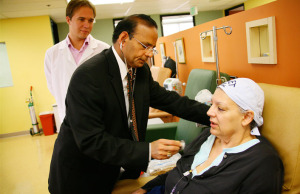Lung Carcinoid Tumor L.A.
Lung carcinoids are a rare, slow growing type of lung cancer tumor. Like most organs in the human body, the lungs are made up of a network of blood vessels, tissue, and cells that help the organs to perform their primary function – breathing in oxygen, and releasing carbon dioxide from the body, in the case of the lungs. Carcinoid tumors originate in a portion of the pulmonary system known as the diffuse neuroendocrine system (neuroendocrine cells are actually found throughout the body and in other organs, such as the stomach and intestines as well).

Lung Carcinoid Tumor L.A.
Cancer is the result of a malfunction in healthy cells that triggers the cells to continue to grow, forming tumors. Neuroendocrine cells are responsible for producing certain types of hormones like adrenaline. Malignant (cancerous) neuroendocrine cells are known as carcinoids, and named after the part of the body in which they are located, such lung carcinoid tumors in the pulmonary system for example.
Dr. Sant P. Chawla and the oncologists at Cancer Center of Southern California use the most advanced, state of the art methods available to treat lung carcinoid tumors in Los Angeles. Lung cancer is generally categorized and identified by the appearance of the tumors under microscope. The four basic types of pulmonary carcinoid tumors include:
- Typical carcinoid tumor – The most common type of carcinoid tumors, they account for nine out of ten carcinoids in the lungs and tend to be slow growing. This form generally does not spread beyond the lungs.
- Atypical carcinoid tumor – Rarer than typical carcinoids, this form tends to grow more quickly and has the potential to spread (metastasize) beyond the lungs.
- Small cell lung cancer (SCLC) – This is the fastest spreading form of all lung cancers.
- Large cell neuroendocrine carcinoma (LCNEC) – A sub-type of non-small cell lung cancer, this form is rare and tends to grow quickly.
Treatment for carcinoid tumors in the lungs will vary from patient to patient and primarily depends on the type, location, and stage of the tumors. The oncology team at Cancer Center of Southern California offers individualized, advanced cancer treatment for lung carcinoid diagnoses, including chemotherapy, radiation, and surgery.
In addition to categorizations based on the pathology of carcinoid tumors under a microscope, pulmonary neuroendocrine tumors are sometimes also further categorized by their location in the lungs.
Central carcinoids – This type is located in the walls of the bronchi, which are the large airways leading to the central part of the lungs. The majority of typical carcinoids are also central.
Peripheral carcinoids – This type is located in the bronchioles, which are the smaller airways located on the outside perimeter of the lungs. Peripheral carcinoids also tend to be mostly typical, but they can also be atypical.
It may seem irrelevant, but the location of a lung carcinoid can affect everything from the symptoms a patient experiences, to the best treatment options and likelihood of successful treatment.
Next, read Lung Carcinoma Chemotherapy


